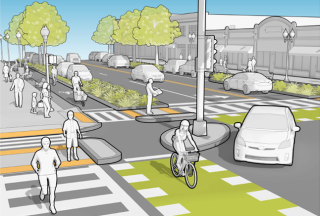Complete Streets

Updating Weymouth’s Tier 2 Complete Streets Prioritization Plan
The Town of Weymouth has recently begun updating the 2016 Tier 2 Prioritization Plan. This process involves assessing needs such as pedestrian connections, safe pedestrian crossings, safe bicycle routes, among many others. In addition to professional assessment and observation, public input in this process is important and welcomed. As part of the project, an online tool has been set up to allow residents and interested parties to input directly to the project. Anyone who has experienced a problem or has an idea related to street safety and travel options in Weymouth is encouraged to access the Town of Weymouth Complete Streets Wikimap, so that the project team can be aware of these issues as the Plan is developed.
A "Complete Street" is one that provides safe, accessible options for people of all ages and abilities and all modes of travel. Designing streets with these principles contributes to the health, safety, and quality of life in a community by improving the pedestrian and vehicular environments and providing safer, more convenient travel options between the places people live, learn, work, and play.
In 2015, the Town adopted its first Complete Streets Policy. The goal of this policy is to incorporate Complete Streets principles into every municipal transportation project. The policy was ranked among the nation's best in a 2015 report by Smart Growth America’s National Complete Streets Coalition.
Watch a short video on Complete Streets in Weymouth here.
What are Complete Streets?
A Complete Street describes a right of way that provides safe and accessible options for people of all ages and abilities and all modes of travel. Complete Streets make it easy to cross the street, walk to shops, and bicycle to work. They allow buses to run on time, and make it safe for people to walk to and from train stations.
There is no singular design prescription for Complete Streets; each is unique and responds to its own community context. A Complete Street in a rural area will look quite different from a Complete Street in a highly urban area, but both are designed to balance safety and convenience for everyone using the road.
What are the benefits of Complete Streets?
Complete Streets help create livable communities for various types of users, including children, people with disabilities, and older adults. Complete Streets improve equity, safety, and public health, while also reducing transportation costs and traffic woes.
The National Complete Streets Coalition developed a series of fact sheets exploring the many benefits of Complete Streets. Find links to these fact sheets below.
- Complete Streets Ease Traffic Woes
- Complete Streets Fight Climate Change
- Complete Streets Help Create Livable Communities
- Complete Streets Help Keep Kids Safe
- Complete Streets Help People with Disabilities
- Complete Streets Improve Mobility for Older Adults
- Complete Streets Improve Safety
- Complete Streets Lower Transportation Costs
- Complete Streets Mean Equitable Streets
- Complete Streets Promote Good Health
- Complete Streets Stimulate the Local Economy
Related Documents/Links
- Video: Pedestrian Safety PSA (WETC-8, Aug 2019)
- Video: Vehicle Safety PSA (WETC-8, Aug 2019)
- Complete Streets Prioritization Plan (GIA, Sep 2016)
- Complete Streets Resolution (DPCD, Dec 2015)
- Complete Streets Policy (DPCD, 2015)
- PEDSAFE: Pedestrian Safety Guide and Countermeasure Selection System (US-FHWA)
- BIKESAFE: Bicycle Safety Guide and Countermeasure Selection System (US-FHWA)
- Crash Modification Clearinghouse (US-FHWA)
- Urban Street Design Guide (NACTO)

